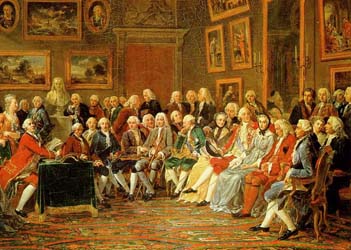American Sinology
2: The West

![]()
The Enlightenment began with Descartes' Discourse on Method (1637). But the ground for a new intellectual age had been prepared by knowledge of China and of techniques first discovered in the East and transmitted by Marco Polo (c1300) and the travelers who followed him. These discoveries included: (1) the art of printing, in the movable-type version refined during the reign of King Sejong (1397-1450) of Korea, which in the hands of Gutenberg (c1400-1468) and others produced an explosion of intellectual life all over Europe; (2) the compass and the the stern-post rudder, which made deep-water navigation possible, abandoned by China in the Ming Dynasty, but in Europe creating an Age of Discovery (including the discovery of America, 1492) and the European maritime empires; and (3) the equal-tempered scale, the invention of the Ming prince Ju Dzai-yw (1584), neglected in China, but in its new setting generating a new art of music, with Bach's "Well-Tempered Clavier" (1722) as its great monument.
China itself was admired in the West as the best-governed country in the world, an unknowing tribute to Confucius, who had done so much to create a dedicated civil service for the Imperial Chinese world which he himself did not live to see. The first Western economic theory, that of the Physiocrats (François Quesnay, 1768) took its inspiration from the agrarian-based economy of China. (It was soon replaced by industrial-based economic theory, that of Adam Smith, 1776, which better reflected current Western conditions).
Missionaries also brought back the essential Chinese texts. The giants of the early days had a remarkable knowledge of the respective languages and cultures, and were concerned to understand the local intellectual and religious tradition, the better to make a case for the system they were introducing. James Legge (1815-1897) in England, and to an almost equal extent, Richard Wilhelm (1873-1930) in Germany, transferred much of the classical learning of China, including its later commentary tradition, to their home countries.
Backgrounmd to American Sinology
- The World
- The West
- America Then
- The War
- America Now